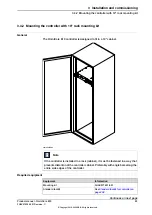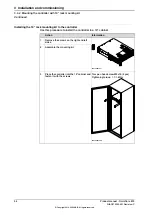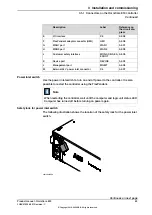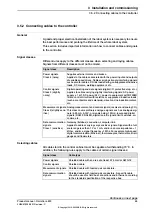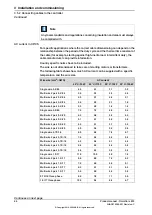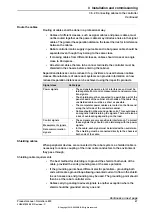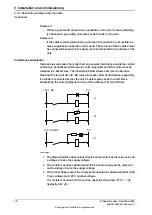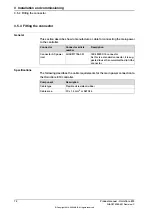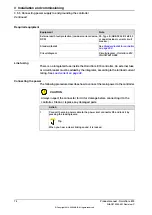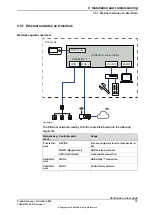
Route the cables
Routing of cables shall be done in a professional way.
•
Cables of different classes, such as signal cables and power cables, must
not be routed together as the power cables may introduce noise in the signal
cables. The greater the separation distance, the lesser the risk for interference
between the cables.
•
Robot controller mains supply input cable and robot power cable should be
separated even though they belong to the same class.
•
If crossing cables from different classes, cables should cross at an angle
close to 90 degrees.
•
All external cables that are to be connected inside the controller must be
shielded in the chassis before entering the cabinet.
Separation distances can be reduced if e.g. dividers are used between cables
classes. Manufacturers of cable duct systems can provide information on how
reduced separation distances can be achieved using their specific products.
Cable type
Signal class
•
These signals generate a lot of interference and must be
laid separate from control, measurement, and communica-
tion signals.
•
The shielding must be connected to a paint-free part of the
panel chassis of the cabinet at both ends of the cable. Any
unshielded cable must be as short as possible.
•
The manipulator power cables are routed on the floor and
along the left side of the controller cabinet.
•
Cables should not be wound up like coils. This could cause
an magnetic field disturbing the signals. There will also be
a risk of overheating depending on the load.
Power signals
•
These signals are very sensitive to interference. To protect
these signals they should not be laid along with the power
signals.
•
In the cable, each signal must be twisted with a neutral wire.
•
The shielding must be connected directly to the chassis at
both ends of the cable.
Control signals
Measurement signals
Data communication
signals
Shielding cables
When peripheral devices are connected to the robot system, a shielded cable is
necessary to reduce coupling of the inner cable conductors to the environment
they pass through.
Shielding cable requirements
•
The best method for shielding is to ground the shield at both ends of the
cable, provided the ends grounding are at the same potential.
•
If the grounding points have different electric potentials - grounding both
ends will create a ground loop allowing unwanted current to flow in the shield.
In such cases one end grounding may be used. The grounding point should
then be at the robot controller side.
•
Cables carrying analog low-level signals is another exception where the
shield should be grounded at only one end.
Continues on next page
Product manual - OmniCore E10
67
3HAC079399-001 Revision: C
© Copyright 2019-2022 ABB. All rights reserved.
3 Installation and commissioning
3.5.2 Connecting cables to the controller
Continued
Содержание OmniCore E10
Страница 1: ...ROBOTICS Product manual OmniCore E10 ...
Страница 2: ...Trace back information Workspace 22A version a10 Checked in 2022 03 02 Skribenta version 5 4 005 ...
Страница 8: ...This page is intentionally left blank ...
Страница 34: ...This page is intentionally left blank ...
Страница 198: ...This page is intentionally left blank ...
Страница 206: ...This page is intentionally left blank ...
Страница 224: ...This page is intentionally left blank ...
Страница 228: ......
Страница 229: ......

